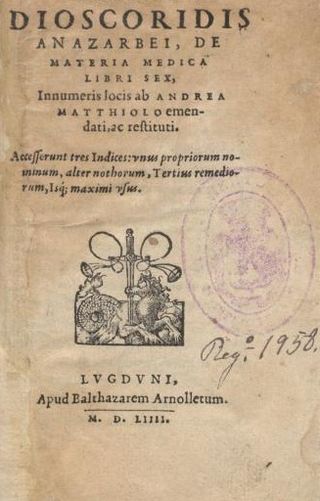
Gentianales is an order of flowering plant, included within the asterid clade of eudicots. It comprises more than 20,000 species in about 1,200 genera in 5 families. More than 80% of the species in this order belong to the family Rubiaceae.

Gentiana is a genus of flowering plants belonging to the gentian family (Gentianaceae), the tribe Gentianeae, and the monophyletic subtribe Gentianinae. With about 400 species, it is considered a large genus. Gentians are notable for their mostly large trumpet-shaped flowers, which are often of an intense blue hue.

Atropa belladonna, commonly known as belladonna or deadly nightshade, is a toxic perennial herbaceous plant in the nightshade family Solanaceae, which also includes tomatoes, potatoes and aubergine (Eggplant). It is native to Europe and Western Asia, including Turkey. Its distribution extends from Ireland in the west to western Ukraine and the Iranian province of Gilan in the east. It is also naturalised or introduced in some parts of Canada, North Africa and the United States.

A bitters is traditionally an alcoholic preparation flavored with botanical matter for a bitter or bittersweet flavor. Originally, numerous longstanding brands of bitters were developed as patent medicines, but now are sold as digestifs, sometimes with herbal properties, and as cocktail flavorings.

Lydia Estes Pinkham was an American inventor and marketer of a herbal-alcoholic "women's tonic" for menstrual and menopausal problems, which medical experts dismissed as a quack remedy, but which is still on sale today in a modified form.

Gentianaceae is a family of flowering plants of 103 genera and about 1600 species.

Contrayerva, or contrajerva, is the medicinal rhizome of various tropical Central American and South American species of Dorstenia in the family Moraceae, mainly Dorstenia contrajerva and the closely related Dorstenia drakena but also Dorstenia brasiliensis. The word contrayerva means “counter herb” in Spanish. It was given this name since a 16th-century description claimed that the leaves of a herb were used by South American Indians to counter the deadly poisonous effect of the same herb when used as an arrow poison. Seventeenth century herbalists and botanists identified this herb as the aromatic root that had been brought from Peru to England by Francis Drake, and claimed that it was an antidote against all kinds of poison. By the late 18th century contrayerva had lost its reputation as an antidote, but it continued to be listed in European and American pharmacopoeias and herbals until the 1920s as a gentle stimulant, tonic and diaphoretic. It is still used in folk medicine in Central and South America.

Gentiana catesbaei, commonly called Elliot's gentian, American gentian, or bottle gentian, is a wildflower native to the eastern North America. It grows in the swampy areas from Virginia to Florida and has showy, pale blue flowers which appear in the late fall from September to December.

Gentiana scabra, also known as the Japanese gentian or the Rindō Flower, is a species of flowering plant in the Gentian family (Gentianaceae), found in much of East Asia. The flowers bloom in mid-summer, autumn and are blue or dark blue in color.

Edward John Waring was a Fellow of the Royal College of Physicians of London and a surgeon in the British East India Company. He wrote several books on medicine including A Manual of Practical Therapeutics (1865), Pharmacopoeia of India (1866), and the two-volume Bibliotheca Therapeutica (1878).

Dorstenia contrajerva is a plant species in the family Moraceae. It is native to Northern South America and Central America, and is cultivated elsewhere. The species name "contrajerva" is the Latinized form of the plant's Spanish name, "contrahierba", a name for plants used for treating poisoning and venomous bites and stings, and for which its rootstocks are used in folk medicine. It is the type species of the Dorstenia genus and was first described by Carl Linnaeus in 1753.
Warburg's tincture was a pharmaceutical drug, now obsolete. It was invented in 1834 by Dr. Carl Warburg.

Amarogentin is a chemical compound found in gentian or in Swertia chirata.

Frasera caroliniensis, commonly known as American columbo or yellow gentian, is a herbaceous perennial of the gentian family Gentianaceae found in the deciduous forest of Southern Ontario and throughout the eastern and southeastern United States. It was previously known as Swertia caroliniensis.

Gentian liqueur is a clear liqueur produced using the roots of the gentian plant.
Donovan's solution is an inorganic compound prepared from arsenic triiodide and mercuric iodide. Despite its name, it is a compound and not a solution.

Ferrous tartrate is a chemical compound and the iron(II) salt of tartaric acid.

De materia medica is a pharmacopoeia of medicinal plants and the medicines that can be obtained from them. The five-volume work was written between 50 and 70 CE by Pedanius Dioscorides, a Greek physician in the Roman army. It was widely read for more than 1,500 years until supplanted by revised herbals in the Renaissance, making it one of the longest-lasting of all natural history and pharmacology books.

Chionogentias diemensis is a flowering herbaceous alpine plant in the family Gentianaceae, endemic to the island of Tasmania in Australia. It is commonly known as the Tasmanian mountain gentian. Chionogentias diemensis has been classified into two sub-species: the Tasmanian snow-gentian and the Ben Lomond snow-gentian.

Gentiana kurroo, also known as Indian gentian or Himalayan gentian, was named after the Illyrian monarch Gentius, who discovered the medicinal properties of the gentian root. Its scientific name, Gentiana kurroo, comes from the native term "karu", meaning "bitter". This perennial herb is critically endangered.




















